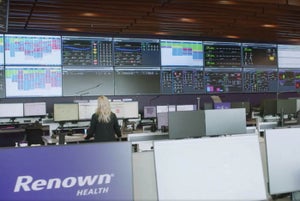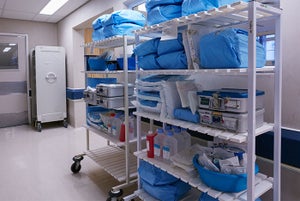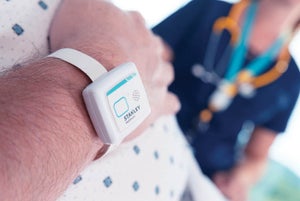Hospital boosts technology to enhance safety and security

Digital footwalls in every patient room within The Valley Hospital will display a history of caregivers entering the room, thanks to an RTLS integration.
Image courtesy of The Valley Hospital
Integrated technology solutions that allow safety and security systems to better work together are at the heart of the security enhancements within the new Valley Hospital in Paramus, N.J.
Smart features include systems that enhance visibility into the location of patients, staff and visitors, and assets to speed response times and proactively address potential security issues.
“By simplifying this into one system, everybody — whether they’re in operations, nursing or security — is looking at the same thing. It’s a big benefit,” explains Eric Carey, vice president and chief information officer at Valley Health System.
For example, employee badges serve as a contactless access control solution, duress button and tracking system that helps patients and families keep track of the clinicians providing care. These functions make use of a real-time locating system (RTLS) that, among other features, will display caregiver information on the 75-inch digital footwall installed in every patient room. In addition to helping patients recognize the roles of the caregivers moving through their room, it helps staff and family members trace the history of care delivered throughout a patient’s stay.
The same RTLS is also integrated within the hospital’s infant protection system. The RTLS is set to trigger an alarm in the event it detects any deviance from the usual travel paths caregivers take infants through, or an unauthorized entry or exit.
RTLS will also help staff more rapidly reach equipment when it’s needed. Carey notes that a similar system installed in the Ridgewood, N.J., hospital, which the new facility replaces, also helped reduce the amount of equipment required on hand. Even more granular RTLS coverage in the new hospital is expected to reduce the time spent searching for equipment and speed caregiver response time.
Systems integrated into the more than 450 security cameras installed throughout the hospital also enhance security and operational efficiency. For example, a badge used to access certain sensitive areas may automatically trigger a camera in that area to display on the screens being viewed by the security team. Integrating cameras with motion sensor capabilities allows security teams to not only monitor access to sensitive areas but also track movement throughout a facility if necessary. This type of integration moves cameras from a reactive security system to a more proactive tool.
“Even with a security dispatch center dedicated 24/7 to watching monitors, you can’t watch hundreds of cameras at all times,” Carey points out. “With automation, you can set triggers for certain cameras to move to a priority screen to get eyes on it.”
It’s the type of network integration that becomes much more cost-effective when built into the design of a new facility. With that in mind, The Valley Hospital has prioritized flexibility to ensure that additional security features can be added in the future.
“We have between 18 and 24 hard-wired network connections per inpatient room. That’s a tremendous amount of cabling,” Carey says. “Running 18 wires to every patient room in the facility at Ridgewood would absolutely have been cost-prohibitive.”
The design team future-proofed the new hospital by running spare cabling and installing network patch panels in each patient room. This makes moving equipment as simple as running a patch cable of a different length, rather than rerunning cables from the patient room to the communications closet. “This is probably a $500,000 to $1 million savings every time anything gets relocated,” Carey says.
The safety advantages of this network design approach are already clear. The hospital will be among the first to install Inspiren’s AUGi platform in every patient room. The platform uses a combination of sensors and artificial intelligence to observe patients and alert nursing staff in the event a fall risk is detected.
“This wasn’t in the initial hospital design,” Carey says. “It’s a brand-new technology. Because we had run spare cabling, we were able to implement that in the patient footwalls.”




